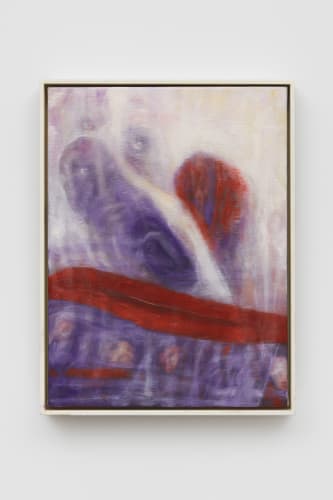What is Freedom? : On Hannah Arendt
Brazilian sound artist and music producer Laima Leyton also responds to each essay in Arendt's publication through a new series of sound pieces commissioned by the gallery, collectively titled Infinite past, infinite future and NOW, available to experience via ‘Saltoun Online’ on our website.
In partnership with the Hannah Arendt Center for Politics and Humanities at Bard College, join us each exhibition for the 'On Hannah Arendt: Virtual Reading Group' as scholars, artists and invited guests discuss key themes in Arendt's writing. The session on ‘What is Freedom?’ will take place on Thursday 17 June at 1pm EST / 6pm GMT, with a special introduction to the essay by Judith Butler. Link to register here.
A video introduction to ‘What is Freedom?’ by Roger Berkowitz, Founder and Director of the Hannah Arendt Center, is available to watch on the gallery’s website.
On Hannah Arendt: What is Freedom? will be the most comprehensive presentation of work by BRACHA (Bracha L. Ettinger, b.1948, Tel Aviv) in the UK for more than a decade. It brings together some fourteen canvases and twenty-five works on paper, many of which will be on display for the first time. For years, Bracha has garnered the attention of some of the world’s leading art historians and curators – particularly those interested in the intersection of art and psychoanalysis, feminist theory, trauma and memory. As a theorist, she has developed her groundbreaking matrixial theory that proposes a new definition of the human subject, rethinking art-making between ethics and aesthetics.
The exhibition will debut work from four new series of paintings, Eurydice—Pietà, Eros—Pietà, Medusa and Kaddish, that continue the artist’s processing of the atrocities carried out on European Jews during World War II. These powerful and moving works draw on mythological imagery of female figures who were mortified as a tool to construct paintings that address historical, transgenerational as well as personal trauma including her family’s first-hand experience with the Ponary massacre of 1941. Bracha manifests these sources as spectral figures suspended between presence and absence, existence and nothingness to evoke categorically human feelings of vulnerability, anxiety and bodily ephemerality.
In our modern world we are led to believe that human rights, the right of self-determination and the right to freedom are self-evident truths, universal concepts applicable to us all. However, in her essay ‘What is Freedom?’ Arendt casts doubt over such certainties, arguing that freedom is simply a mirage that it is neither attainable in an inner (psychological) sense nor in an outer (practical) sense, since our behaviours are constantly subject to forces that shape and guide our actions. In Arendt’s opinion, the only way to approach freedom is through action. She argues that inner feeling – without action – is merely a retreat from the world and a failure to actively participate in it. Even though it has been established since early antiquity that freedom can be found within oneself, Arendt contends that this must not be mistaken for the real work, which can only exist in an interrelatedness with the world.
For Bracha, the very act of painting is free – freedom articulated through compassion and witnessing – to the extent that it can transcend the theoretical constraints and challenge philosophy. Bracha has described how, over time, she came to understand “with anguish [theory’s] poverty in the domain of art and of the feminine.” This type of freedom can be found by examining closely Bracha’s creative process and by looking carefully at the time periods in which each work is produced. The dates of production can range anywhere between two and six years and, in some instances, even longer. These extraordinary timeframes are certainly rare for a contemporary painter and are an attempt to derive the concept of freedom and other concepts related to the human condition, violence, borderlinking and the Unconscious from the experience of painting itself. They demonstrate how fundamental time is for Bracha as a factor in the painting’s realization and, like space, a material, as well as a subject-matter in and of itself, which can bring forth something tangible that modifies thought. Seeing the paintings through this lens reminds us how dominated we are in many aspects of our daily lives through invisible chains, and that art can offer a critique of hidden structures attached to our experience of space and time as it is so heavily regulated by social and economic drivers that perpetually exert authority over outer and inner experience.
Bracha’s exhibition ‘On Hannah Arendt: What is Freedom?’ is organized as part of Richard Saltoun Gallery’s 12-month program dedicated to the writings of the German-born, American political philosopher Hannah Arendt, which takes its title from the fourth essay of her 1968 book Between Past and Future.
Brazilian sound artist and music producer Laima Leyton also responds to each essay in Arendt's publication through a new series of sound pieces commissioned by the gallery, collectively titled Infinite past, infinite future and NOW, available to experience via ‘Saltoun Online’ on our website.
In partnership with the Hannah Arendt Center for Politics and Humanities at Bard College, join us each exhibition for the 'On Hannah Arendt: Virtual Reading Group' as scholars, artists and invited guests discuss key themes in Arendt's writing. The session on ‘What is Freedom?’ will take place on Thursday 17 June at 1pm EST / 6pm GMT, with a special introduction to the essay by Judith Butler. Link to register here.
A video introduction to ‘What is Freedom?’ by Roger Berkowitz, Founder and Director of the Hannah Arendt Center, is available to watch on the gallery’s website.














